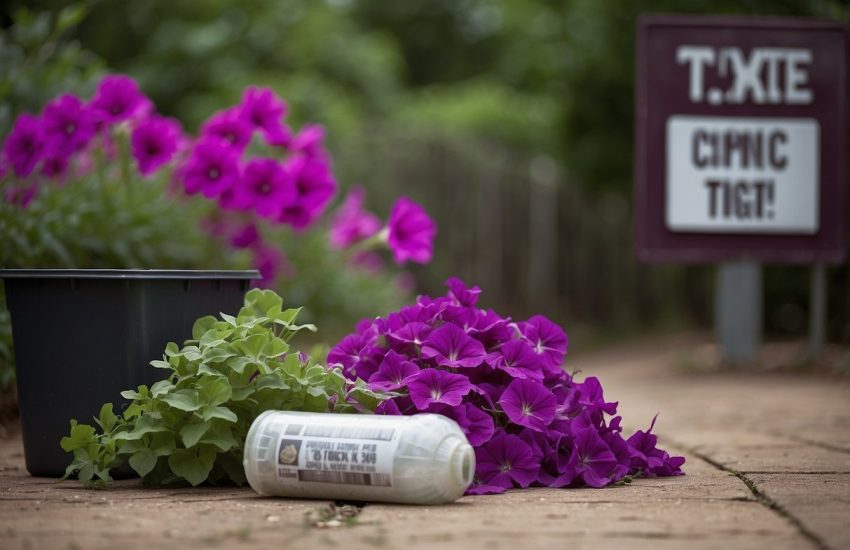Our Favorite Ground Cover Plants to Grow in Connecticut
Groundcovers are an important part of any landscape for several reasons. First, they help to prevent Soil erosion by stabilizing the ground and protecting against wind and water damage. Second, they can help conserve soil moisture, making them ideal for use in drought-prone areas. Third, groundcovers help to suppress weeds by creating a dense mat of foliage that blocks out sunlight and prevents weed seeds from germinating. Considering the benefits of ground covers, it would be a wise move to have some in your garden or yard. While there are many ground covers available, it is important to select ones that are suited to the geographical location you are at. Here are some ground covers that you can grow in Connecticut.
Pearly Everlasting (Anaphalis margaritacca)
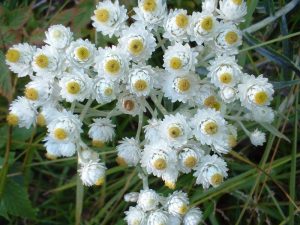
Pearly Everlasting (Anaphalis margaritacea) is a beautiful addition to any garden. It is an annual herb that grows up to two feet tall and produces small, white flowers. The leaves are lance-shaped and covered in silvery-white down. Pearly Everlasting is native to North America and can be found growing in open woods, meadows, and roadsides. It is easy to grow from seed, and once established, it will self-seed itself. The best time to plant Pearly Everlasting is in the spring or fall. To plant from seed, simply scatter the seeds on the ground and lightly cover them with soil. Once the seedlings have emerged, thin them out so that they are about six inches apart. Pearly Everlasting does not require much care; it is drought-tolerant and does not need to be fertilized. It prefers full sun but will also grow in partial shade. The main problem with Pearly Everlasting is that it can be invasive; if left unchecked, it will spread rapidly and crowd out other plants. If you are concerned about its invasiveness, it is best to plant it in a container. Pearly Everlasting makes an excellent cut flower and can be used fresh or dried. The flowers can also be used to make a pleasing herbal tea.
Cardinal Flower (Lobelia cardinalis)
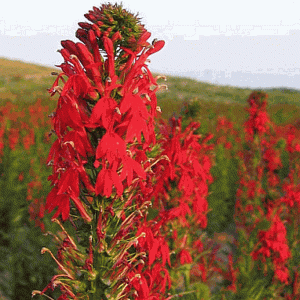
The Cardinal Flower (Lobelia cardinalis) is a beautiful addition to any garden. This perennial plant is native to North America and can be found in woodlands, wetlands, and along streams and lakes. It is a member of the bellflower family, and its vibrant red blooms are a favourite among hummingbirds and butterflies. The Cardinal Flower gets its name from its vibrant red flowers, which bloom from late summer to early fall. The plant grows to be about two to three feet tall, and the leaves are dark green and lance-shaped. The flowers are borne on spikes that rise above the foliage, each with five petals. The Cardinal Flower is a popular choice for butterfly gardens, as the nectar is highly attractive to these pollinators. It performs best in moist, well-drained soil and prefers full sun to partial shade. The plant blooms from July to September and usually reaches a height of 2-3 feet. The Cardinal Flower is a beautiful addition to any garden and will surely attract attention from both humans and wildlife alike.
Riverbank grape (Vitis riparia)
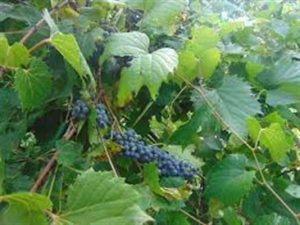
Riverbank grape (Vitis riparia) is a grape native to North America. It is a vigorous vine, capable of growing up to 30 feet in a single season. The leaves are large and heart-shaped, with serrated edges. The flowers are small and green, borne in clusters of 6-8. The fruit is a small black grape, usually less than an inch in diameter. Riverbank grape is tolerant of a wide range of soil and climatic conditions and can be found growing in both wild and cultivated settings. It can be found growing in full sun or partial shade and prefers moist, well-drained soil. The vine is often used in landscaping for its attractive foliage and grapes. It is also an important food source for wildlife, including birds and mammals.
Shrubby fivefingers (Sibbaldiopsis tridentata)
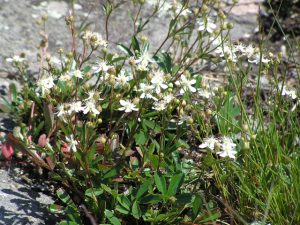
Shrubby Fivefingers (Sibbaldiopsis tridentata) is a member of the Rose family (Rosaceae) and is native to North America. It is a low-growing shrub, reaching a height of only 10-20 cm. It has slender, erect stems covered in small, dark green leaves. The leaves are simple, alternate, and deeply lobed, with the lobes arranged in threes (hence the Latin name tridentata, meaning “three-toothed”). From late spring to early summer, the shrub is covered in delicate white flowers, which are followed by small, dark berries. The berries are an important food source for birds and other wildlife. Shrubby Fivefingers prefers to grow in moist, well-drained soils in partial shade but is also tolerant of full sun and dry conditions. This versatile shrub makes an excellent addition to any garden, providing year-round interest and attracting a range of wildlife.
Little bluestem (Schizachyrium scoparium)
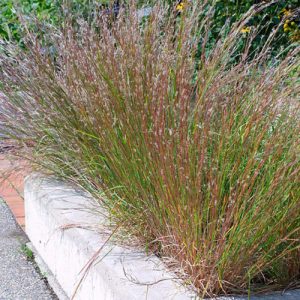
Little bluestem (Schizachyrium scoparium) is a species of grass in the family Poaceae. It is native to North America and occurs in Canada and the United States. Little bluestem is a perennial grass that forms tufts of thin, erect leaves. The leaves are blue-green and have a hairy surface. The inflorescence is a spikelet with two to five florets. The flowers are brown or reddish and have three stamens. The fruit is a grain that is dark brown or black. Little bluestem grows in a variety of habitats, including prairies, savannas, and woods. It is an important forage grass for cattle and other grazing animals. Little bluestem is a hardy plant that is tolerant of drought and poor soil conditions. Other than a ground cover, the plant is also used as an ornamental plant in gardens and landscaping.
Lyreleaf sage (Salvia lyrata)
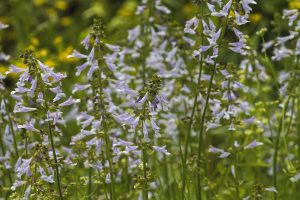
Lyreleaf sage (Salvia lyrata) is a low-growing, evergreen perennial native to the southeastern United States. It typically grows to 6-12 inches tall and spreads 12-18 inches wide. It is a member of the mint family (Lamiaceae) and has a square-shaped stem. The leaves are simple and opposite, with a lyre-shaped base and toothed margins. They are dark green and have a furry texture. The flowers are two-lipped and borne in spikes at the tips of the stems; they are purplish-blue in color and bloom in the spring. Lyreleaf sage is relatively easy to care for and is tolerant of most soil types. It prefers full sun but will tolerate partial shade. It is drought tolerant once established. Lyreleaf sage is an excellent addition to any garden or landscape. It can be used as an accent plant, groundcover, or border plant. It is also deer resistant.
Checkerberry (Gaultheria procumbens)
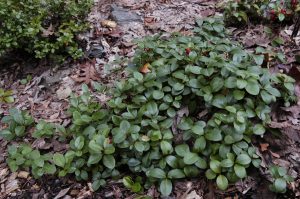
Checkerberry (Gaultheria procumbens) is a low-growing, spreading shrub that is native to North America. The leaves are oval-shaped, and the upper surface is covered with small, dark green tissue that has a velvety texture. The undersides of the leaves are paler in color and have a smooth texture. The flowers of the checkerberry are white and borne in clusters of two or three. The fruit is a small, dark red berry that ripens in late summer or early fall. Checkerberry is often used as an ornamental plant and is also prized for its ability to attract birds. The berries are an important food source for many species of songbirds. In addition, the checkerberry’s strong roots help to stabilize the soil and prevent erosion. The plant is also known by several other names, including boxberry, wintergreen, and teaberry.
Devil’s darning needles (Clematis virginiana)

Devil’s darning needles (Clematis virginiana ) are a species of flowering plant in the buttercup family. They are native to eastern North America, found in woodlands, fields, and along roadsides. The plant gets its common name from the long, thin seed pods that resemble sewing needles. The flowers are small and white, with four petals arranged in a cross formation. Devil’s darning needles grow to be about 2-3 feet tall and produce seeds from June to August. The wind disperses the seeds, and the plant reproduces primarily through vegetative means. When the leaves of the plant are crushed, they emit a strong, unpleasant odor. This has led to another common name for the plant: stinking Virgin’s bower. While it is not considered an endangered species, many gardeners consider Devil’s darning needles a nuisance due to their aggressive growth habits.
Hoary Mountain Mint (Pycnanthemum incanum)
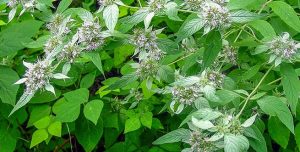
Hoary Mountain Mint (Pycnanthemum incanum) is a perennial herb in the mint family native to eastern North America. This plant gets its common name from the white, woolly hairs that cover its leaves and stems. The hairy leaves are ovate to triangular in shape and are opposite each other on the stem. They are arranged in whorls of 6-8 leaves around the stem, with each leaf having 3-5 lobes. The Hoary Mountain Mint flowers from July to September, producing dense clusters of white or lavender flowers. Each flower has four petals and four stamens and is about 1 cm in diameter. The Hoary Mountain Mint grows best in full sun to partial shade and prefers moist soils. It is a popular plant for pollinators such as bees and butterflies and is also often used in dried flower arrangements.
Marginal woodfern (Dryopteris marginalis)
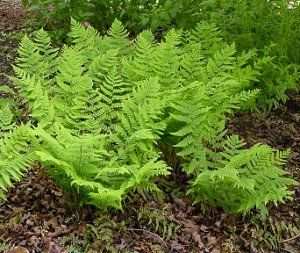
Marginal woodfern, or Dryopteris marginalis is a species of fern in the Dryopteridaceae family. It is commonly known as the marginal woodfern or leatherleaf fern. It is native to North America and can be found in woods and other shady areas from Newfoundland to Alberta and Minnesota. The plant grows up to 1.2 m tall and has a spreading rhizome system. The stipe is dark brown and hairless, while the lamina is paler and textured with scales. The spores are produced on the underside of the lamina in clusters known as sori. When mature, the sori are covered by a thin membrane called the indusium. D. marginalis is an evergreen perennial that can be propagated by division or spores. It is widely cultivated as an ornamental plant for its attractive foliage. It is also used in horticulture for erosion control and as a ground cover in shady areas.
Starry false lily (Maianthemum stellatum)
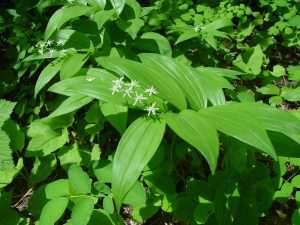
Starry false lily (Maianthemum stellatum) is a perennial herb in the family Asparagaceae, native to North America. It is found in woodlands and forest edges from Newfoundland to Alaska south to New Jersey, West Virginia, Ohio, Michigan, Minnesota, and Idaho. The plant grows 10–50 cm (4–20 in) tall with a basal rosette of leaves and a raceme of white flowers. The leaves are ovate to elliptical with entire margins and measure 2–9 cm (0.8–3.5 in) long by 1–5 cm (0.4–2 in) wide. The flowers have six tepals and are borne on pedicels 2–3 cm (0.8–1.2 in) long. The fruit is a dark blueberry 6–8 mm (0.24–0.31 in) wide, containing two seeds. Bees and flies pollinate starry false lily, and birds eat the berries. The plant is a food source for the larvae of moths in the genus Eudonia including Eudonia ellentonensis and Eudonia lacustrata.
Starry false lily is found in moist, shady locations such as woods or forest edges. It prefers humus-rich soil that is high in organic matter. The plant can propagate vegetatively by rhizomes or by seed. It flowers from May to June, and the berries ripen in August or September. Starry false lily is sometimes grown as an ornamental plant in shady gardens. It has gained the Royal Horticultural Society’s Award of Garden Merit (AGM).
Arctic brome (Bromus kalmii)
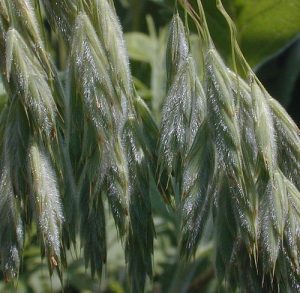
Bromus kalmii, or Arctic brome, is a perennial grass that is native to northern North America. It typically grows to a height of 30-60 cm (12-24 inches), with slender, upright stems that are sparsely covered in small, sharp leaves. The plant’s flowers are small and insignificant, but they give rise to distinctive, club-shaped fruits that are covered in fine hairs. Arctic brome is a hardy plant that is tolerant of poor soil and harsh weather conditions. It is often used as a cover crop or forage grass and has some ornamental value. However, the plant can be invasive in some areas and difficult to control once it becomes established.

